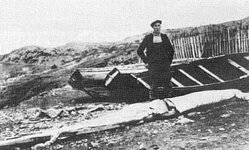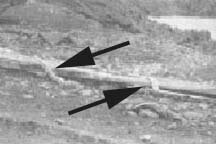Hmm.
An elementray school in Holyrood has the photo up on their home page, with no information attached to it. The school's home page, does, however, state that Holyrood is near the mouth of Conception Bay, Newfoundland. As this stretch of salt has seen several recorded Archie finds, there are at least two other stranding events to consider, and one of them is pretty intriguing.
Before I go any farther, here's the link to the Michael J. Sweeney's "Record of Architeuthis Specimens." It's a PDF file, but at 286 KB it's a pretty fast download, even for slower internet access methods (such as mine, gah). At well over a hundred pages in length, a printout of this essential document will be an imposing presence on your desk, and at parties.
PDF Record of Architeuthis Specimens.
An Architeuthis was recovered in Conception Bay, near Brigus, in October of 1879. Arm length for this specimen is given as 8 feet, perhaps a bit long for the proportions shown in the Holyrood photo, but, who knows, they might have given them a good pull before measuring them. The Smithsonian list does not indicate whether or not the Brigus animal was photographed.
And then, there's this one, November 10, 1881, "near St. John's, Portugal Cove." Location: Canada, Newfoundland, BL [Body Length]=5.5ft; HL [Head Length]=1.25ft; EL [Entire Length]=28ft." (Sweeney) This specimen was apparently photographed by one E. Lyons in St. John's. The squid was then purchased for exhibition in the Worth Museum, an old curiosities exhibit in lower Manhattan. Shipped on ice to New York, the squid was subsequently fixed in preservative.
A mantle and head measurement of almost 7 feet could also work for the Holyrood squid, judging from the photo. (I've just realized that I tend to use subjective scaling when looking at photos of people, thus imagining everyone is 6 feet tall. That Newfie, for example, could have been Napoleon's sparring partner, for all I know

) It's also possible that the Logy Bay squid was the one that appeared in a photo, head and arms only, draped over a an old metal bath, reproduced in Ellis's "Search for the Giant Squid," among others. Don't have that book with me...the rest of you have it, I know.
What tickles me about the St. John's/Portugal Cove squid is the association with the Worth Museum in New York. Was it the squid that was used as a pattern for the line of papier-mache models that were sold to museums? That's somewhere in Ellis's book, I know. Mostly, I wonder if the Worth's exhibited squid was involved in an obscure Harry Houdini performance, too smelly to imagine, whereby the great escape artist freed himself from confinement with a dead giant squid. Taningia Danae metioned this in a post a while ago, but I don't recall ever finding more details online. Did Houdini ever perform at Worth's?
Clem


 methinks....
methinks....

 to TONMO, and I'm sure many of us would love to read & see more!
to TONMO, and I'm sure many of us would love to read & see more!